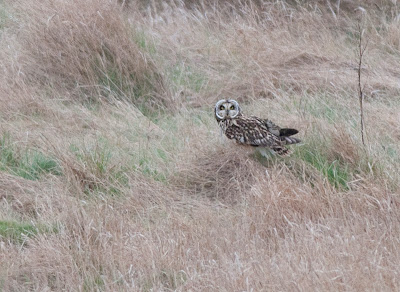
I found the nest without any trouble and after a five-minute wait one of the pair showed up with nesting material, and entered the nest. I got a few photos, but I think I was slightly too close as the bird seemed a bit on edge, so I moved on.
I decided to head for Tyler hide, and noticed straight away that a) there were a number of geese close in on the near slopes of the Serengeti and b) one of said geese was this. The same Red-breasted Goose that was here last year? Though it's (almost certainly) feral it was still a lovely bird to see.
Excitable squeaky sounds from a distant island indicated that the Little Ringed Plovers are back. I counted four, all running about frantically and displaying with puffed-out belly feathers. They were far too far away for anything but record shots - the low water levels mean they are spoiled for choice for muddy island shorelines.
Several of the Lapwings were also in display mode, making their comical tooting and scrunching noises while performing wild aerobatics.
The male pictured above made a sudden dive at the stretch of shore right in front that you can't see from the hide, and drove out a Snipe, chasing the poor thing away. Then it came back and flushed out a second Snipe. By the time it returned a third time I was as ready as I could be and grabbed some shots (this was the only one not disastrously blurred) of Snipe no. 3 as the intolerant Lapwing pursued it.
Further entertainment came in the form of this Pied Wagtail feeding very near my window.
Wildfowl numbers are quite low on the East Lake, though there remained a good few Teals, at least one pair of Gadwalls and a solitary Shoveler drake. Two pairs of Great Crested Grebes were on view, and there are still a lot of gulls around, mostly subadults.
Exiting the hide I disturbed a Green Woodpecker, which was good enough to land again not too far away. My view was very obscured though, hence the rather misty look of the photo.
I walked down towards Slingsby hide, going past the tree where I'd seen Long-tailed Tit nest-building activity recently. This time I spotted the nest itself, very near the path, and just as I saw it one of the pair slipped out and away, making some soft and discreet alarm calls. I carried on quickly, to let it return.
From the Eric Sutton hide (finally committed that name to memory!) I saw... not a lot, a few Teals, gulls, a Lapwing. For completeness I also visited Kingfisher and Slingsby hides, startling a female Pheasant on the way. I was scanning the trees for a Lesser Spotted Woodpecker, in vain as usual, but did see several Great Spots including this female.
I'd heard a couple of singing Blackcaps around, but it wasn't until halfway to Willow hide that I managed just about to get a photo of one. This male was hiding among the ivy, as there is no deciduous foliage for him to hide in yet.
Just after the Blackcap I spotted a Stock Dove high in a tree and was photographing it, rather amazed that it hadn't flown off, when a Woodpigeon arrived and landed below it. I thus had the chance to photograph these two sometimes-confused species together. It is surprising how obvious the Stock Dove's dark eyes are, even from a distance.
Then I found another Stock Dove on its own, and this one similarly didn't freak out and fly away at the sight of me but sat quietly in the branches while I took its picture.
From Willow hide all was very quiet. A few Canada Geese and Coots drifted about, a female Teal suddenly pitched down in front of the windows and flew away again almost immediately, and a Cormorant dived for fish in what looked like very shallow water. No sign of the Mute Swan pair, and their regular nest site is being left high and dry by the expanding muddy shores, so maybe they will breed elsewhere this year.
From the reedbed outside Willow hide sang this Wren, the showiest of several that I saw. This reedy clump usually harbours a Reed Warbler from mid-April. No singing Reed Warblers or (more surprisingly) Reed Buntings around today.
I walked all the way past Long Lake, hoping to find a butterfly or two on the meadowy patch at the far end. No joy. It was strange to be out and about on such a warm day and see no butterflies at all. There are plenty out on other sites, but not here. I did see a Bee-fly though.
There was some reward for walking all the way - a trio of Ring-necked Parakeets eating willow catkins opposite the field that marks the furthest bit you're allowed to walk here. They seemed unphased by my close approach and were still munching away when I left.
On the way back I called in at Carter hide, just so I could say I'd visited every hide (not that anyone is likely to ask). The Kingfisher perches were bathed in sunshine, and I did actually see a Kingfisher here but it wasn't hanging around, and certainly wasn't going to pose for me. I couldn't complain, though, it had been a lovely morning.




















































